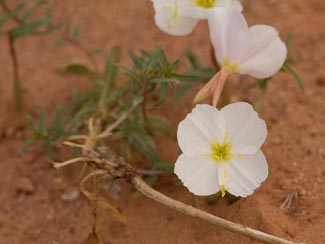Pale Evening Primrose

Common Name(s):
Pale Evening-primrose
Pale Primrose
White Buttercup
Scientific Name:
Oenothera pallida Lindl.
Scientific Name Synonyms:
None known
Symbol:
OEPA
Description:
Growth Characteristics: Pale evening primrose grow 4-27 inches tall, spreads out to 24-30 inches, blooms May until December.
Flowers: Pale evening primrose has large, 2-3 inch blooms and a yellow eye. Blooms are white fading to pink. Petals have noticeable yellow/green patches at their base.
Fruits/Seeds: Capsules which are conspicuously 4-winged.
Leaves: Pale evening primrose leaves are narrow and can be entire, toothed, lobed, etc.
Stems: Stems of pale evening primrose are white and exfoliating.
Roots: Rhizomatous
Ecological Adaptions:
Pale evening primrose is found in semi-desert, and foothills systems.
Soils: Well-drained, rocky, sandy soils.
Associated Species: Pinyon pine, Utah juniper, shadscale.
Uses and Management:
Cattle seem to avoid evening-primrose. Young shoots and roots of some evening-primroses are eaten by humans.

